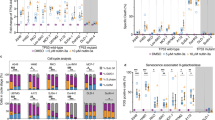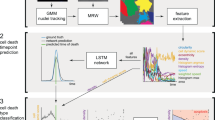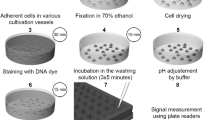Abstract
The use of annexin A5 (A5) and either propidium iodide or 7-aminoactinomycin D (PI/7-AAD) stains to measure cell death by flow cytometry has been considered the gold standard by most investigators. However, this widely used method often makes the assumption that there are only three types of particles in a sample: viable, apoptotic and necrotic cells. To study the progression of cell death in greater detail, in particular how apoptotic cells undergo fragmentation to generate membrane-bound vesicles known as apoptotic bodies, we established a flow cytometry–based protocol to accurately and rapidly measure the cell death process. This protocol uses a combination of A5 and TO-PRO-3 (a commercially available nucleic acid–binding dye that stains early apoptotic and necrotic cells differentially), and a logical seven-stage analytical approach to distinguish six types of particles in a sample, including apoptotic bodies and cells at three different stages of cell death. The protocol requires 1–5 h for sample preparation (including induction of cell death), 20 min for staining and 5 min for data analysis.
This is a preview of subscription content, access via your institution
Access options
Subscribe to this journal
Receive 12 print issues and online access
$259.00 per year
only $21.58 per issue
Buy this article
- Purchase on Springer Link
- Instant access to full article PDF
Prices may be subject to local taxes which are calculated during checkout




Similar content being viewed by others
References
Hakem, R. et al. Differential requirement for caspase 9 in apoptotic pathways in vivo. Cell 94, 339–352 (1998).
Vermes, I., Haanen, C., Steffens-Nakken, H. & Reutelingsperger, C. A novel assay for apoptosis. Flow cytometric detection of phosphatidylserine expression on early apoptotic cells using fluorescein labelled annexin V. J. Immunol. Methods 184, 39–51 (1995).
Arruda, D.C. et al. β-actin-binding complementarity-determining region 2 of variable heavy chain from monoclonal antibody C7 induces apoptosis in several human tumor cells and is protective against metastatic melanoma. J. Biol. Chem. 287, 14912–14922 (2012).
Yao, P.M. & Tabas, I. Free cholesterol loading of macrophages induces apoptosis involving the Fas pathway. J. Biol. Chem. 275, 23807–23813 (2000).
Herault, O. et al. A role for GPx3 in activity of normal and leukemia stem cells. J. Exp. Med. 209, 895–901 (2012).
Deng, S. et al. UCP2 inhibits ROS-mediated apoptosis in A549 under hypoxic conditions. PLoS ONE 7, e30714 (2012).
Hristov, M., Erl, W., Linder, S. & Weber, P.C. Apoptotic bodies from endothelial cells enhance the number and initiate the differentiation of human endothelial progenitor cells in vitro. Blood 104, 2761–2766 (2004).
Li, N., Wang, M., Oberley, T.D., Sempf, J.M. & Nel, A.E. Comparison of the pro-oxidative and proinflammatory effects of organic diesel exhaust particle chemicals in bronchial epithelial cells and macrophages. J. Immunol. 169, 4531–4541 (2002).
van Engeland, M., Nieland, L.J., Ramaekers, F.C., Schutte, B. & Reutelingsperger, C.P. Annexin V-affinity assay: a review on an apoptosis detection system based on phosphatidylserine exposure. Cytometry 31, 1–9 (1998).
Koopman, G. et al. Annexin V for flow cytometric detection of phosphatidylserine expression on B cells undergoing apoptosis. Blood 84, 1415–1420 (1994).
Kozako, T. et al. Novel small-molecule SIRT1 inhibitors induce cell death in adult T-cell leukaemia cells. Sci. Rep. 5, 11345 (2015).
Mirzayans, R. et al. Spontaneous gammaH2AX foci in human solid tumor-derived cell lines in relation to p21WAF1 and WIP1 expression. Int. J. Mol. Sci. 16, 11609–11628 (2015).
Poon, I.K., Hulett, M.D. & Parish, C.R. Molecular mechanisms of late apoptotic/necrotic cell clearance. Cell Death Differ. 17, 381–397 (2010).
Poon, I.K., Lucas, C.D., Rossi, A.G. & Ravichandran, K.S. Apoptotic cell clearance: basic biology and therapeutic potential. Nat. Rev. Immunol. 14, 166–180 (2014).
Schmid, I., Krall, W.J., Uittenbogaart, C.H., Braun, J. & Giorgi, J.V. Dead cell discrimination with 7-amino-actinomycin D in combination with dual color immunofluorescence in single laser flow cytometry. Cytometry 13, 204–208 (1992).
van Genderen, H. et al. In vitro measurement of cell death with the annexin A5 affinity assay. Nat. Protoc. 1, 363–367 (2006).
Gyorgy, B. et al. Membrane vesicles, current state-of-the-art: emerging role of extracellular vesicles. Cell. Mol. Life Sci. 68, 2667–2688 (2011).
Poon, I.K. et al. Unexpected link between an antibiotic, pannexin channels and apoptosis. Nature 507, 329–334 (2014).
Atkin-Smith, G.K. et al. A novel mechanism of generating extracellular vesicles during apoptosis via a beads-on-a-string membrane structure. Nat. Commun. 6, 7439 (2015).
Johansson, A.C., Steen, H., Ollinger, K. & Roberg, K. Cathepsin D mediates cytochrome c release and caspase activation in human fibroblast apoptosis induced by staurosporine. Cell Death Differ. 10, 1253–1259 (2003).
Friis, M.B. et al. Cell shrinkage as a signal to apoptosis in NIH 3T3 fibroblasts. J. Physiol. 567, 427–443 (2005).
Brakenhielm, E. et al. Adiponectin-induced antiangiogenesis and antitumor activity involve caspase-mediated endothelial cell apoptosis. Proc. Natl. Acad. Sci. USA 101, 2476–2481 (2004).
Stasilojc, G. et al. U937 variant cells as a model of apoptosis without cell disintegration. Cell. Mol. Biol. Lett. 18, 249–262 (2013).
Rosenblatt, J., Raff, M.C. & Cramer, L.P. An epithelial cell destined for apoptosis signals its neighbors to extrude it by an actin- and myosin-dependent mechanism. Curr. Biol. 11, 1847–1857 (2001).
Witasp, E. et al. Bridge over troubled water: milk fat globule epidermal growth factor 8 promotes human monocyte-derived macrophage clearance of non-blebbing phosphatidylserine-positive target cells. Cell Death Differ. 14, 1063–1065 (2007).
Rubartelli, A., Poggi, A. & Zocchi, M.R. The selective engulfment of apoptotic bodies by dendritic cells is mediated by the αvβ3 integrin and requires intracellular and extracellular calcium. Eur. J. Immunol. 27, 1893–1900 (1997).
Berda-Haddad, Y. et al. Sterile inflammation of endothelial cell-derived apoptotic bodies is mediated by interleukin-1α. Proc. Natl. Acad. Sci. USA 108, 20684–20689 (2011).
Zernecke, A. et al. Delivery of microRNA-126 by apoptotic bodies induces CXCL12-dependent vascular protection. Sci. Signal. 2, ra81 (2009).
Bergsmedh, A. et al. Horizontal transfer of oncogenes by uptake of apoptotic bodies. Proc. Natl. Acad. Sci. USA 98, 6407–6411 (2001).
Chekeni, F.B. et al. Pannexin 1 channels mediate 'find-me' signal release and membrane permeability during apoptosis. Nature 467, 863–867 (2010).
Kaku, Y., Tsuchiya, A., Kanno, T. & Nishizaki, T. HUHS1015 induces necroptosis and caspase-independent apoptosis of MKN28 human gastric cancer cells in association with AMID accumulation in the nucleus. Anticancer Agents Med. Chem. 15, 242–247 (2015).
Penuela, S. et al. Pannexin 1 and pannexin 3 are glycoproteins that exhibit many distinct characteristics from the connexin family of gap junction proteins. J. Cell Sci. 120, 3772–3783 (2007).
Baranova, A. et al. The mammalian pannexin family is homologous to the invertebrate innexin gap junction proteins. Genomics 83, 706–716 (2004).
Penuela, S., Harland, L., Simek, J. & Laird, D.W. Pannexin channels and their links to human disease. Biochem. J. 461, 371–381 (2014).
Fadeel, B. et al. Phosphatidylserine exposure during apoptosis is a cell-type-specific event and does not correlate with plasma membrane phospholipid scramblase expression. Biochem. Biophys. Res. Commun. 266, 504–511 (1999).
Fadok, V.A., de Cathelineau, A., Daleke, D.L., Henson, P.M. & Bratton, D.L. Loss of phospholipid asymmetry and surface exposure of phosphatidylserine is required for phagocytosis of apoptotic cells by macrophages and fibroblasts. J. Biol. Chem. 276, 1071–1077 (2001).
Chandler, W.L., Yeung, W. & Tait, J.F. A new microparticle size calibration standard for use in measuring smaller microparticles using a new flow cytometer. J. Thromb. Haemost. 9, 1216–1224 (2011).
Rousseau, M. et al. Detection and quantification of microparticles from different cellular lineages using flow cytometry. Evaluation of the impact of secreted phospholipase A2 on microparticle assessment. PLoS ONE 10, e0116812 (2015).
Poon, I. et al. Phosphoinositide-mediated oligomerization of a defensin induces cell lysis. Elife 3, e01808 (2014).
Baxter, A.A. et al. The tomato defensin TPP3 binds phosphatidylinositol (4,5)-bisphosphate via a conserved dimeric cationic grip conformation to mediate cell lysis. Mol. Cell. Biol. 35, 1964–1978 (2015).
Poon, I.K., Hulett, M.D. & Parish, C.R. Histidine-rich glycoprotein is a novel plasma pattern recognition molecule that recruits IgG to facilitate necrotic cell clearance via FcγRI on phagocytes. Blood 115, 2473–2482 (2010).
Poon, I.K., Parish, C.R. & Hulett, M.D. Histidine-rich glycoprotein functions cooperatively with cell surface heparan sulfate on phagocytes to promote necrotic cell uptake. J. Leukoc. Biol. 88, 559–569 (2010).
Philpott, N.J. et al. The use of 7-amino actinomycin D in identifying apoptosis: simplicity of use and broad spectrum of application compared with other techniques. Blood 87, 2244–2251 (1996).
Lay, F.T. et al. Dimerization of plant defensin NaD1 enhances its antifungal activity. J. Biol. Chem. 287, 19961–19972 (2012).
Dunai, Z.A. et al. Staurosporine induces necroptotic cell death under caspase-compromised conditions in U937 cells. PLoS ONE 7, e41945 (2012).
Unal Cevik, I. & Dalkara, T. Intravenously administered propidium iodide labels necrotic cells in the intact mouse brain after injury. Cell Death Differ. 10, 928–929 (2003).
Fink, S.L. & Cookson, B.T. Caspase-1-dependent pore formation during pyroptosis leads to osmotic lysis of infected host macrophages. Cell. Microbiol. 8, 1812–1825 (2006).
Moujalled, D.M., Cook, W.D., Murphy, J.M. & Vaux, D.L. Necroptosis induced by RIPK3 requires MLKL but not Drp1. Cell Death Dis. 5, e1086 (2014).
Case, C.L. et al. Caspase-11 stimulates rapid flagellin-independent pyroptosis in response to Legionella pneumophila. Proc. Natl. Acad. Sci. USA 110, 1851–1856 (2013).
Lawlor, K.E. et al. RIPK3 promotes cell death and NLRP3 inflammasome activation in the absence of MLKL. Nat. Commun. 6, 6282 (2015).
Hristov, G. et al. SHOX triggers the lysosomal pathway of apoptosis via oxidative stress. Hum. Mol. Genet. 23, 1619–1630 (2014).
Darzynkiewicz, Z., Galkowski, D. & Zhao, H. Analysis of apoptosis by cytometry using TUNEL assay. Methods 44, 250–254 (2008).
Acknowledgements
This work was supported by grants from the National Health and Medical Research Council of Australia (nos. APP1013584 and APP1082383), La Trobe University (nos. RFA2014 and RFA2015) and a Ramaciotti Establishment Grant to I.K.H.P.
Author information
Authors and Affiliations
Contributions
L.J., R.T. and I.K.H.P. designed, performed and analyzed most of the experiments with help and input from S.C., G.K.A.-S. and S.P. A.A.B., M.D.H., L.J. and I.K.H.P. designed and carried out experiments with rNaD1. I.K.H.P., L.J. and R.T. wrote the manuscript with input from co-authors.
Corresponding author
Ethics declarations
Competing interests
The authors declare no competing financial interests.
Integrated supplementary information
Supplementary Figure 1 Traditional electronic gating strategy for analysing cell death based on A5-FITC and 7-AAD.
a, Flow cytometry analysis showing the traditional two-stage electronic gating strategy used to identify viable cells, A5+ early apoptotic cells and necrotic cells. b, Flow cytometry analysis displaying each type of cells gated according to a has distinctive levels of A5-FITC and 7-AAD staining. Human Jurkat T cells were induced to undergo apoptosis by anti-Fas treatment (31.25 ng ml-1, 4 h). Samples were stained with A5-FITC (1 in 200 dilution), 7-AAD (1 μg ml-1) and TO-PRO-3 (0.5 μM) in 1x A5 Binding Buffer. 30,000 events (cells and cell fragments) were recorded by the FACSCanto II flow cytometer and resultant data analysed by the FlowJo 8.8.6 software. The TO-PRO-3 parameter was not used during data analysis.
Supplementary Figure 2 The nucleic acid-binding dye TO-PRO-3 stains viable, early apoptotic and necrotic cells differentially.
a, Histogram showing TO-PRO-3 uptake by viable, A5- early apoptotic, A5+ early apoptotic and necrotic cells. b, Uptake of TO-PRO-3 by cells at different stages of cell death. Data is presented as median fluorescence intensity (MFI) relative to viable cells (n = 3, experimental replicates). Human Jurkat T cells were induced to undergo apoptosis by anti-Fas treatment (31.25 ng ml−1, 4 h). Samples were stained with A5-FITC (1 in 200 dilution), 7-AAD (1 μg ml−1) and TO-PRO-3 (0.5 μM) in 1x A5 Binding Buffer. 30,000 events (cells and cell fragments) were recorded by the FACSCanto II flow cytometer. Resultant data were analysed by the FlowJo 8.8.6 software using the electronic gating strategy as described in Figure 3. Alternative STAGE 1 gating step was used to identify necrotic cells based on the 7-AAD parameter. Error bars represent standard error of the mean. Data are representative of at least two independent experiments.
Supplementary Figure 3 Representative images of typical particles in each stage of cell death.
ImageStream analysis of particles gated using the strategy as described in Poon et al., Nature 507, 329–334 (2014). Human Jurkat T cells were induced to undergo apoptosis by anti-Fas treatment (250 ng ml−1, 4 h). Samples were stained with A5-FITC (1 in 200 dilution), 7-AAD (1 μg ml−1) and TO-PRO-3 (0.5 μM) in 1x A5 Binding Buffer. Cells and cell fragments were recorded by the ImageStreamX Mark II and resultant data analysed by the IDEAS software. The data shown were previously published in Poon et al., Nature 507, 329–334 (2014).
Supplementary Figure 4 Electronic gating strategy for analysing cell death based only on TO-PRO-3.
Flow cytometry analysis showing a one-stage electronic gating strategy used to identify viable cells, early apoptotic cells (A5− and A5+), necrotic cells, as well as apoptotic bodies and debris. Human Jurkat T cells were induced to undergo apoptosis by anti-Fas treatment (31.25 ng ml−1, 4 h). Samples were stained with A5-FITC (1 in 200 dilution), 7-AAD (1 μg ml−1) and TO-PRO-3 (0.5 μM) in 1x A5 Binding Buffer. 30,000 events (cells and cell fragments) were recorded by the FACSCanto II flow cytometer and resultant data analysed by the FlowJo 8.8.6 software. The A5-FITC and 7-AAD parameter was not used during data analysis.
Supplementary information
Supplementary Text and Figures
Supplementary Figures 1–4, Supplementary Methods and Supplementary Data 1 (PDF 1313 kb)
Rights and permissions
About this article
Cite this article
Jiang, L., Tixeira, R., Caruso, S. et al. Monitoring the progression of cell death and the disassembly of dying cells by flow cytometry. Nat Protoc 11, 655–663 (2016). https://doi.org/10.1038/nprot.2016.028
Published:
Issue Date:
DOI: https://doi.org/10.1038/nprot.2016.028
This article is cited by
-
Apoptotic bodies: bioactive treasure left behind by the dying cells with robust diagnostic and therapeutic application potentials
Journal of Nanobiotechnology (2023)
-
cGAS inhibition alleviates Alu RNA-induced immune responses and cytotoxicity in retinal pigmented epithelium
Cell & Bioscience (2022)
-
Externalized phosphatidylinositides on apoptotic cells are eat-me signals recognized by CD14
Cell Death & Differentiation (2022)
-
Plasma membrane permeabilization following cell death: many ways to dye!
Cell Death Discovery (2021)
-
ROCK1 but not LIMK1 or PAK2 is a key regulator of apoptotic membrane blebbing and cell disassembly
Cell Death & Differentiation (2020)
Comments
By submitting a comment you agree to abide by our Terms and Community Guidelines. If you find something abusive or that does not comply with our terms or guidelines please flag it as inappropriate.



